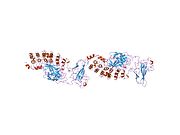Biology:IκBα
 Generic protein structure example |
IκBα (nuclear factor of kappa light polypeptide gene enhancer in B-cells inhibitor, alpha) is one member of a family of cellular proteins that function to inhibit the NF-κB transcription factor. IκBα inhibits NF-κB by masking the nuclear localization signals (NLS) of NF-κB proteins and keeping them sequestered in an inactive state in the cytoplasm.[1] In addition, IκBα blocks the ability of NF-κB transcription factors to bind to DNA, which is required for NF-κB's proper functioning.[2]
Disease linkage
The gene encoding the IκBα protein is mutated in some Hodgkin's lymphoma cells; such mutations inactivate the IκBα protein, thus causing NF-κB to be chronically active in the lymphoma tumor cells and this activity contributes to the malignant state of these tumor cells.[3]
Interactions
IκBα has been shown to interact with:
- BTRC,[4][5]
- C22orf25,[6]
- CHUK,[7][8][9][10]
- DYNLL1,[11]
- G3BP2,[12]
- Heterogeneous nuclear ribonucleoprotein A1,[13]
- IKK2,[7][8][14]
- NFKB1,[13][15]
- P53,[16]
- RELA,[5][7][13][15][17][18][19]
- RPS6KA1,[20]
- SUMO4,[21] and
- Valosin-containing protein.[22]
References
- ↑ "Structure of an IkappaBalpha/NF-kappaB complex". Cell 95 (6): 749–58. 1998. doi:10.1016/S0092-8674(00)81698-0. PMID 9865693.
- ↑ "Rel/NF-kappa B/I kappa B family: intimate tales of association and dissociation". Genes Dev. 9 (22): 2723–35. 1995. doi:10.1101/gad.9.22.2723. PMID 7590248.
- ↑ "Mutations in the IkBa gene in Hodgkin's disease suggest a tumour suppressor role for IkappaBalpha". Oncogene 18 (20): 3063–70. 1999. doi:10.1038/sj.onc.1202893. PMID 10340377.
- ↑ "Homodimer of two F-box proteins betaTrCP1 or betaTrCP2 binds to IkappaBalpha for signal-dependent ubiquitination". J. Biol. Chem. 275 (4): 2877–84. January 2000. doi:10.1074/jbc.275.4.2877. PMID 10644755.
- ↑ 5.0 5.1 "Signal-induced ubiquitination of IkappaBalpha by the F-box protein Slimb/beta-TrCP". Genes Dev. 13 (3): 284–94. February 1999. doi:10.1101/gad.13.3.284. PMID 9990853.
- ↑ "Molecular Interaction Database". http://mint.bio.uniroma2.it/mint/Welcome.do.
- ↑ 7.0 7.1 7.2 "IKAP is a scaffold protein of the IkappaB kinase complex". Nature 395 (6699): 292–6. September 1998. doi:10.1038/26254. PMID 9751059. Bibcode: 1998Natur.395..292C.
- ↑ 8.0 8.1 "IkappaB kinase-beta: NF-kappaB activation and complex formation with IkappaB kinase-alpha and NIK". Science 278 (5339): 866–9. October 1997. doi:10.1126/science.278.5339.866. PMID 9346485. Bibcode: 1997Sci...278..866W.
- ↑ "A cytokine-responsive IkappaB kinase that activates the transcription factor NF-kappaB". Nature 388 (6642): 548–54. August 1997. doi:10.1038/41493. PMID 9252186.
- ↑ "The kinase TAK1 can activate the NIK-I kappaB as well as the MAP kinase cascade in the IL-1 signalling pathway". Nature 398 (6724): 252–6. March 1999. doi:10.1038/18465. PMID 10094049. Bibcode: 1999Natur.398..252N.
- ↑ "I kappaB alpha physically interacts with a cytoskeleton-associated protein through its signal response domain". Mol. Cell. Biol. 17 (12): 7375–85. December 1997. doi:10.1128/MCB.17.12.7375. PMID 9372968.
- ↑ "IkappaBalpha and IkappaBalpha /NF-kappa B complexes are retained in the cytoplasm through interaction with a novel partner, RasGAP SH3-binding protein 2". J. Biol. Chem. 275 (46): 36441–9. November 2000. doi:10.1074/jbc.M004751200. PMID 10969074.
- ↑ 13.0 13.1 13.2 "Interaction between hnRNPA1 and IkappaBalpha is required for maximal activation of NF-kappaB-dependent transcription". Mol. Cell. Biol. 21 (10): 3482–90. May 2001. doi:10.1128/MCB.21.10.3482-3490.2001. PMID 11313474.
- ↑ "IkappaB kinase (IKK)-associated protein 1, a common component of the heterogeneous IKK complex". Mol. Cell. Biol. 19 (2): 1526–38. February 1999. doi:10.1128/mcb.19.2.1526. PMID 9891086.
- ↑ 15.0 15.1 "Ikappa Balpha functions through direct contacts with the nuclear localization signals and the DNA binding sequences of NF-kappaB". J. Biol. Chem. 273 (39): 25427–35. September 1998. doi:10.1074/jbc.273.39.25427. PMID 9738011.
- ↑ "The non-ankyrin C terminus of Ikappa Balpha physically interacts with p53 in vivo and dissociates in response to apoptotic stress, hypoxia, DNA damage, and transforming growth factor-beta 1-mediated growth suppression". J. Biol. Chem. 277 (12): 10323–31. March 2002. doi:10.1074/jbc.M106607200. PMID 11799106.
- ↑ "Duration of nuclear NF-kappaB action regulated by reversible acetylation". Science 293 (5535): 1653–7. August 2001. doi:10.1126/science.1062374. PMID 11533489. Bibcode: 2001Sci...293.1653C.
- ↑ "Post-activation turn-off of NF-kappa B-dependent transcription is regulated by acetylation of p65". J. Biol. Chem. 278 (4): 2758–66. January 2003. doi:10.1074/jbc.M209572200. PMID 12419806.
- ↑ "Purification, reconstitution, and I kappa B association of the c-Rel-p65 (RelA) complex, a strong activator of transcription". Mol. Cell. Biol. 14 (4): 2593–603. April 1994. doi:10.1128/mcb.14.4.2593. PMID 8139561.
- ↑ "IkappaB alpha is a target for the mitogen-activated 90 kDa ribosomal S6 kinase". EMBO J. 16 (11): 3133–44. June 1997. doi:10.1093/emboj/16.11.3133. PMID 9214631.
- ↑ "A functional variant of SUMO4, a new I kappa B alpha modifier, is associated with type 1 diabetes". Nat. Genet. 36 (8): 837–41. August 2004. doi:10.1038/ng1391. PMID 15247916.
- ↑ "Involvement of valosin-containing protein, an ATPase Co-purified with IkappaBalpha and 26 S proteasome, in ubiquitin-proteasome-mediated degradation of IkappaBalpha". J. Biol. Chem. 273 (6): 3562–73. February 1998. doi:10.1074/jbc.273.6.3562. PMID 9452483.
Further reading
- "Regulation of human immunodeficiency virus type 1 and cytokine gene expression in myeloid cells by NF-kappa B/Rel transcription factors.". Microbiol. Rev. 59 (3): 481–505. 1995. doi:10.1128/MMBR.59.3.481-505.1995. PMID 7565415.
- "Control of NF-kappa B transcriptional activation by signal induced proteolysis of I kappa B alpha.". Philos. Trans. R. Soc. Lond. B Biol. Sci. 354 (1389): 1601–9. 2000. doi:10.1098/rstb.1999.0504. PMID 10582246.
- "HIV-1 Vpr and anti-inflammatory activity.". DNA Cell Biol. 23 (4): 239–47. 2004. doi:10.1089/104454904773819824. PMID 15142381.
- "Alpha-interferon and its effects on signal transduction pathways.". J. Cell. Physiol. 202 (2): 323–35. 2005. doi:10.1002/jcp.20137. PMID 15389589.
- "The Vpr protein from HIV-1: distinct roles along the viral life cycle.". Retrovirology 2 (1): 11. 2006. doi:10.1186/1742-4690-2-11. PMID 15725353.
- "HIV-1 viral protein R (Vpr) & host cellular responses.". Indian J. Med. Res. 121 (4): 270–86. 2005. PMID 15817944.
- "NFKB and NFKBI polymorphisms in relation to susceptibility of tumour and other diseases.". Histol. Histopathol. 22 (12): 1387–98. 2007. PMID 17701919.
External links
- OMIM entries on Ectodermal Dysplasia, Anhidrotic, with T-cell Immunodeficiency
- NFKBIA+protein,+human at the US National Library of Medicine Medical Subject Headings (MeSH)
- NF-kappaB+inhibitor+alpha at the US National Library of Medicine Medical Subject Headings (MeSH)
- Overview of all the structural information available in the PDB for UniProt: P25963 (NF-kappa-B inhibitor alpha) at the PDBe-KB.
 |



